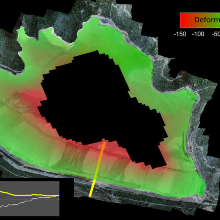The European satellite mission Sentinel-1 was the launched in 2014. It acquires synthetic aperture radar (SAR) images globally. The weather independency of this active remote sensing technique allows this system to sample the whole earth every 12 (6 for Europe) days. Due to the COPERNICUS open data policy, all images can be used free of charge.
Because of the coherent nature of the SAR sensor, pairs of images can be analyzed interferometrical. The phase difference in the received signal allows a deduction about a change in the surface. Advanced differential interferometric SAR (DInSAR) analyses like small baseline subset (SBAS) and persistent scatterer interferometry (PSI) are examining dozens of consequential SAR images. They take in account complex atmosphere correction, and deformation models to achieve an estimation of deformation velocities better 1cm/year.
In an EIT research project, we are investigate the possibilities of DInSAR for cost efficient monitoring of tailing dams around the world. A tailing dam is typically an earth-fill embankment dam used to store byproducts of mining operations after separating the ore from the gangue. The sudden failures of such dams in 2015 and 2019 in Brazil and Myanmar have shown the necessity of new strategies to monitor critical dams globally.
Since all Sentinel-1 images since 2014 are available in the archive, we can analyze the behavior of the collapsed dams, to compare them with stable ones and derive spatial and temporal patterns of critical deformation.
The project is carried out in a partnership with the remote sensing company EFTAS.

Uwe Sörgel
Prof. Dr.-Ing.Director of the Institute



